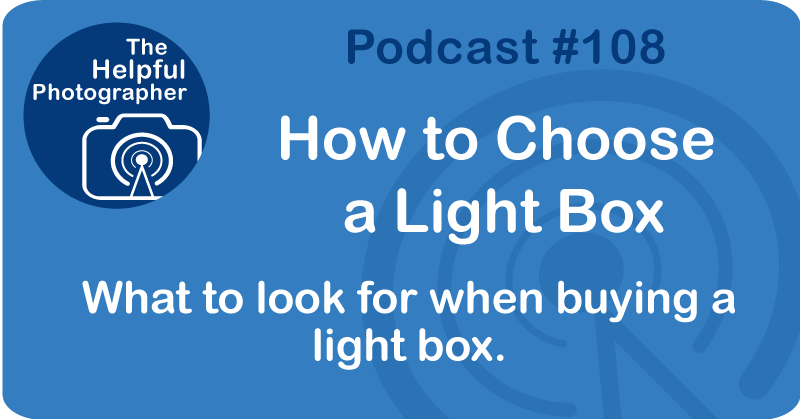How to Choose a Light Box #108
How to Choose a Light Box #108

There are a lot of people out there who need to do small product photography. From food, to jewelry, to knick-knacks sold on Etsy. And to simplify things, they're often reaching for something called a light box. This is usually a square box that comes with a couple of lights. They seem simple enough. The sample photos of products shot with these boxes look great. The videos seem to indicate that all you have to do is turn on the lights, place your object in the middle, and that's it. Unfortunately, it's never that simple. And if it were, we would have stopped paying photographers thousands of dollars to shoot products a decade ago.
The first thing you should know is that most of the sample photos were not shot in the box, or they were heavily photoshopped. Ask me how I know. I'm starting to think my next podcast should be called, Ask Me How I Know. Seriously though, there are telltale signs. You're just going to have to trust me on this.
Although a lightbox can offer a simple and compact solution, here's what you should know.The purpose of using a light box is to create a soft light on your subject. The easiest way to achieve this is to bounce a light off of a large white surface like a white wall or a large white mat board. Another option is to diffuse the light by shining it through a translucent material like silk or tissue paper. How far you place the light from the bounce surface or the translucent material will also change how soft the light is.
Commercially available light boxes usually come in three varieties. The first is a white translucent box where you can place your subject inside and you provide your own lights, which would be my choice. The second is a box that comes with lights that you place on the outside of the box. And third is a box with lights that are integrated inside the box. For the most part, the last option is a horrible idea. Remember what I just said, the purpose of a box is to help you achieve a soft light and the best way is not to use direct light.
If the lights are inside the box, shining on your subject, that's direct light, and it will be difficult to get that soft, diffused look. The worst boxes I've seen have an array of LEDs on the inside, which means you'll have little white dots all over your subject if your subject is at all reflective. So why would I buy a box that doesn't come with lights? Because then you can use any lights you want, including the sun or a desk lamp on the outside of the box shining in.
Although the purpose of the box is to create a soft light, you have to remember that we do not see just because there is a presence of light, but we see in combination with the absence of light. In other words, shadows. If there are no shadows, then the object will look two-dimensional. If you can control the placement of your lights, you can place the shadows where you want it to enhance your subject. At the moment, it is now becoming more difficult to find systems that have lights that are movable.
Most systems on Amazon seem to come with an LED array that is stuck to the sides of the box so you have very little control over what you're doing. As for the size of the box you should buy, it should be big. As big as you can afford financially and space-wise. For small jewelry, I would suggest a box that is at least 24 by 24 inches. Although this sounds big, think about this. A studio shooter once said to me, no matter how large the studio space is, you never seem to have enough space. I have shot in coves that were 20 feet by 15 feet deep, and within a half an hour, I'm climbing on top of stuff, even though all I was shooting was a tabletop object. It's totally ridiculous, but trust me, the more space you have, the easier it'll be. With all of this in mind, could you just build the box yourself? Sure, why not? I've even made light boxes out of clear plastic file boxes lined with copy paper to diffuse the light. Although that's a pretty small amount of space, I know what I'm doing. For folks with less experience, you're going to need a lot more space. As for how to manipulate the light or what exactly to do with your light, unfortunately, this is a podcast and not YouTube, so it's kind of useless to talk you through that. I hope that was helpful. Until next time, keep on shooting.










